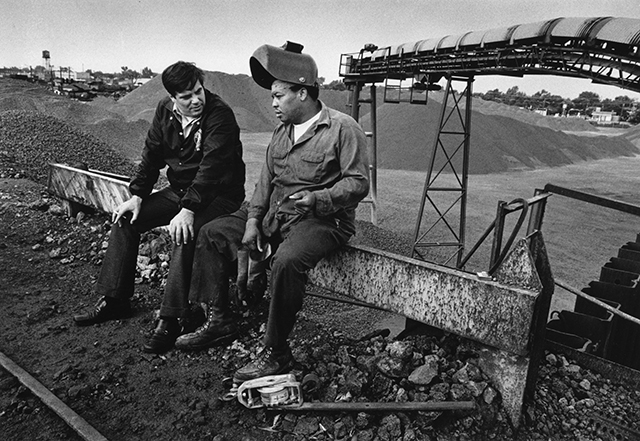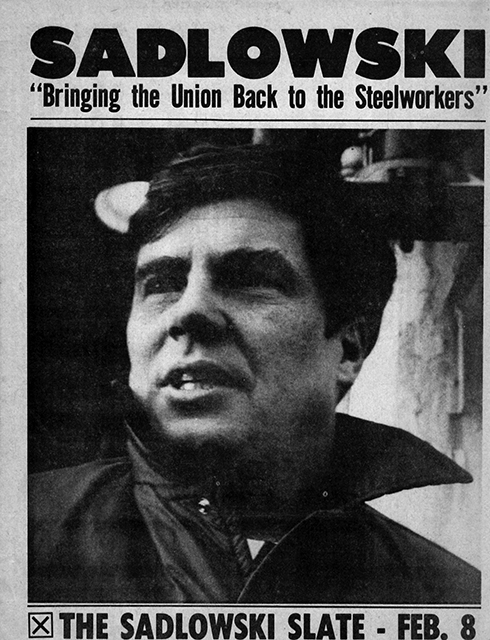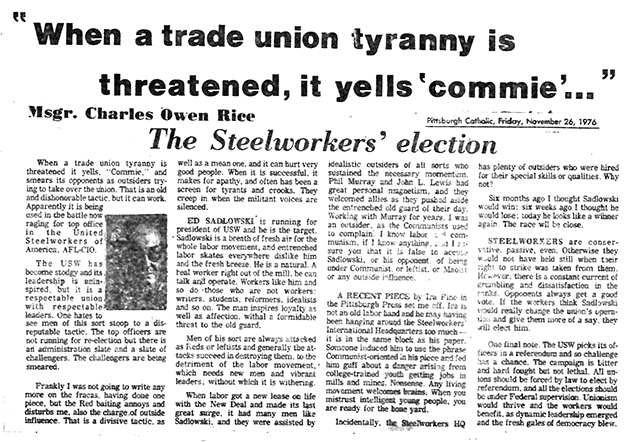Requiem for a Steelworker: Mon Valley Memories of “Oil Can” Eddie
By Steve Early
The Stansbury Forum is fortunate to have several contributors who worked on the Sadlowski campaign. The two following pieces, first by Steve Early and second by Garrett Brown, are from two of them.

Ed campaigning in Gary, Indiana. Photo copyright: Earl Dotter
In progressive circles in the upper mid-west today, if you’ve heard the name Sadlowski, it’s probably because you were involved in the Wisconsin labor uprising of 2011, where you might have linked arms with AFSCME organizer and state capitol occupier Edward A. Sadlowski. Or maybe you applauded the electoral victory of his sister, Susan Sadlowski Garza, when she won a Chicago city council seat four years later, as a standard bearer for her union, the Chicago Teachers.
Ed, Susie, and their union comrades were up against two would-be union busters, Republican Governor Scott Walker in Wisconsin and Rahm Emanuel, the corporate Democrat who is mayor of Chicago. Now both Sadlowskis are mourning the death of 80-year old Edward Eugene Sadlowski, after what his son calls “a hard struggle” of a different sort. The cause of death, on June 10, was Lewy body dementia, a condition that drove Robin Williams to suicide.
Four decades ago, their father was a really big name in the United Steelworkers (then the USWA), well-known throughout organized labor, and a hero of the labor left. As director of USWA District 31, covering Chicago and Gary, Ed Sadlowski was the elected leader of 130,000 blue-collar workers, part of a USWA membership then totaling 1.4 million, about twice what it is today. In a challenge to authority rare among union officials of his rank, Sadlowski broke with top USWA leaders in Pittsburgh who were too cozy with management. Backed by a campaign network called Steelworkers Fight Back (SFB), he ran for international president on a controversial platform calling for greater union democracy, shop floor militancy, protection of black workers’ rights, and the right to strike.
In the mid-1970s, Mid-western cities were still ringed with the glowing hearths of steel mills instead of their post-industrial rubble (or, in the case of US Steel’s fabled Homestead (Pa.) Works, a shopping mall built on top of it). Donald Trump’s delusional aspirations for the coal industry today were a reality then; our nation had more than two hundred thousand underground miners. Unions like the United Mine Workers and the much larger USWA and Teamsters negotiated master contracts that were industry-wide. Owners of steel mills and trucking companies signed agreements covering half a million workers at the same time.
In the era before de-regulation, de-industrialization, and corporate globalization, such union density and bargaining clout produced good wages and benefits. But discontent, among blue-collar workers, over poor working conditions was too often ignored. Problems like compulsory over-time, job safety and health hazards, unfair discipline, and relentless management pressure for greater productivity spawned dissident activity, which took the form of unauthorized strikes or internal union election challenges.
Revolt From Below
At the local level, if union officials failed to provide proper representation, aggrieved members often took matters into their own hands. They by-passed grievance-arbitration procedures that were frustrating and overly legalistic. Risking injunctions, fines, and even jail time, they flouted the “no strike” clauses found in almost every U.S. labor agreement. In 1972, a slate of rank-and-file coal miners, with just that kind of wildcat strike experience, made U.S. labor history when they toppled the corrupt and thuggish national leadership of the UMWA. Inspired in part by these Miners for Democratic, restive truckers and warehouse workers formed Teamsters for a Democratic Union (TDU) a few years later, with much help from socialists among them.
In an era when rank-and-file rebellion was the wave to ride, young Ed Sadlowski was a pretty good surfer. His father, known as “Load,” worked for Inland Steel in East Chicago, joined the Steel Workers Organizing Committee in the 1930’s and became a founding member of USWA Local 1010. Eddie’s own nickname—“Oil Can”—came from his job oiling equipment at US Steel’s South Works in 1956.
For a budding, second-generation union activist, this relatively low-status position proved to be an in-plant organizer’s dream. He was able to circulate widely and connect with disgruntled co-workers throughout a mill employing 14,000 members of USWA Local 65. In 1964, when Sadlowski was only 26, he led a local reform slate to victory, against much older incumbents, and became president of Local 65. (In today’s labor movement, local union presidents under the age of thirty are exceedingly rare.)
An Official Family
Less than a decade later, after a brief stint on the District 31 staff, Sadlowski found out how much his union (and others, in that period) welcomed promising new leaders. When he tried to run for District 31 director, the union’s “official family,” as it was called, rallied around his better-connected opponent. The election was stolen but the US Department of Labor ordered a re-run under federal-supervision. Backed by USWA pioneers like George Patterson, a picket captain who survived Republic Steel’s massacre of strikers in 1937, Sadlowski won that vote by a 2 to 1 margin. In 1975, he became a most unwelcome addition to an international executive board then headed by USWA President I.W. Abel, a 68-year old gent fond of black-tie dinner soirees with Big Steel management.
Abel’s strategy, as a “labor statesman” nearing retirement, involved not just discouraging grievance strikes, but also promising, in advance, that steelworkers wouldn’t strike when their national contract expired. This questionable approach, allegedly dictated by industry conditions, was dubbed the Experimental Negotiating Agreement (ENA). Sadlowski became the USWA’s leading critic of Abel’s experiment because ENA replaced the right to strike with binding arbitration and was negotiated, in secret, without any membership vote approving it. (When his deal was challenged in court, Abel claimed a bargaining black-out was necessary because, with any advance publicity, ENA “might have been rejected.”)
Sadlowski decided to take his case, against the ENA and other manifestations of “tuxedo unionism,” directly to the membership, in a February, 1977 election to choose Abel’s successor. Abel, his e-board colleagues, and USWA headquarters staff cobbled together an establishment ticket headed by Lloyd McBride, the union’s bland but loyal District 34 director from St. Louis. McBride strongly defended the ENA and accused Sadlowski of promoting an “impractical kind of pure democracy that would lead to chaos.”
A Civil Rights Struggle
Long before bumper stickers appeared on Volvos urging us to “Celebrate Diversity,” Sadlowski did just that when he assembled his own insurgent slate. In addition to himself, a Polish-American, the Fight Back slate included a Chicano, a Croatian-American, a Jew of Eastern European origin, and an African-American. (This rainbow coalition made for quite a mouthful on lunch-pail and helmet stickers—“Elect Sadlowski, Rodriques, Kmec, Weinstock, and Montgomery!”)
As of 1976, no African-American had ever made it to the top ranks of America’s second largest industrial, during the first four decades of its existence. In the 1960s, persistent racial discrimination in the mills and under-representation of black members in the USWA bureaucracy spawned a civil rights movement within the union. One of its leaders was Oliver Montgomery from Youngstown, who became Fight Back’s most articulate spokesman (out-shining even the presidential candidate himself on many occasions). To undercut Sadlowski’s appeal to minority workers, with a formidable ally like Montgomery, USWA headquarters created a new vice-presidency for “human rights.” The position was filled by an Abel Administration loyalist, whose main qualification was not being part of past civil rights agitation within the union.
On the ground, the Fight Back campaign swarmed with lefties, young and old. Most were “colonizers,” toiling in difficult and dirty steel mill jobs. This gave them essential shop-floor access to potential Sadlowski voters, most importantly in locals controlled by supporters of Lloyd McBride. Each competing political sect—from the old Communist Party to the Revolutionary Communist Party to the Socialist Workers Party and the International Socialists—had a different “line,” leading to much jockeying for position among their respective cadres. Only the Chairman Mao-inspired October League dismissed the USWA election as “a trick by the bourgeoisie to channel the revolutionary aspirations and strivings of the masses into reformism.”
Liberal Cult Figure?
Meanwhile, anti-communists were attacking Sadlowski with more impact than the October League. Anonymous plant gate flyers in the Mon Valley, where I was a SFB volunteer, claimed that our candidate favored a ban on all gun ownership—not exactly a popular position in (I)Deer Hunter country. Our many external critics included right-wing social democrats allied with conservative AFL-CIO president George Meany. Their aggressive red-baiting focused on Old Left friends and allies of Sadlowski in Chicago and former staffers of the United Mine Workers in Washington, DC. Under new UMW leadership, the latter had already ruined labor relations in the coalfields. Now, these same “outsiders” (of whom I was one) were trying to disrupt USWA functioning too.
In Pittsburgh, we sought to counter such smears by enlisting one of the nation’s premier labor priests (before that breed became nearly extinct). At his dark-paneled Pittsburgh office, Msgr. Charles Owen Rice expressed some pastoral regret about having been a red-baiter himself in the 1950s, doing much local damage to left-wing unions like the United Electrical Workers. Perhaps as an act of personal penance, Rice soon penned a column in the Pittsburgh Catholic that we quickly reprinted and distributed widely at shift change in the mills.
The old monsignor sadly observed that the USWA had become “stodgy and its leadership uninspired.” According to Rice, Ed Sadlowski was “a breath of fresh air for the whole labor movement…Workers like him and so do those who are not workers—students, writers, reformers, and idealists of all sorts. The man inspires loyalty as well as affection and thus represents a formidable threat to the old guard.”
As he barnstormed around the country, giving rousing speeches in every available working class meeting place, Sadlowski received some supportive media coverage. But business-oriented scribes like the young David Ignatius, then at the Wall Street Journal, found lots of reasons to prefer “the old guard.” According to Ignatius, Sadlowski was just “an engaging young union official unsullied by the experience of major responsibility…a momentary liberal cult figure…with a short and un-distinguished record.” Why, Ignatius wondered, should anyone be drawn to romantic invocation of past-industrial union glory when modern-day steel workers should be content with “actual organized power and stability, as evoked by Lloyd McBride.”
Inside the union, USWA headquarters deployed an army of appointed “staff men”—International Union reps who were then almost entirely male—to ensure McBride’s victory in February, 1977. Only four of these 800 full-time pay-rollers dared to endorse Sadlowski (and two of those were members of his own slate!) USWA field staff wielded much influence over elected officers and stewards in the thousands of smaller USWA shops they serviced. Many used their workplace visits—ostensibly for grievance handling or contract negotiations–to do heavy campaigning for McBride, a misappropriation of union resources often hard to document in post-election complaints.
After a grueling contest, with all the trappings of an electoral campaign for public office, about 580,000 USWA members trooped to the polls in hundreds of local union halls. Balloting on this scale made Sadlowski vs McBride the biggest direct election ever held by a U.S. union. Of course, competition in that category is virtually non-existent today. Only the Teamsters—as part of a court-approved racketeering case settlement—regularly hold contested referendum votes for top officers, after grassroots campaigning by incumbents and TDU-backed candidates every five years. Most national union leaders are chosen at more easily controlled conventions of several thousand delegates, or fewer.
Unfortunately, 57% of those voting on February 8, 1977, embraced Lloyd McBride, rather than the “breath of fresh air” represented by Sadlowski and SFB. The Association for Union Democracy, which organized and funded poll watching for Sadlowski, suspected that election fraud tainted the outcome. This time, the Department of Labor didn’t agree that the Landrum-Griffin Act had been violated.
A Changed Union Culture
After Sadlowski lost, he returned to his old District 31 staff job, kept his head down, and beavered away, for many years, as a servicing rep. He was shielded from headquarters retaliation, initially, by the fact that his elected successor, as district director, was Jim Balanoff, a longtime friend, ally, and SFB stalwart. Steelworkers Fight Back did not become a long-distance runner like TDU. But, even as it was disappearing as a formal oppositional network, Sadlowski campaign veterans in Ohio, Pennsylvania, Illinois, and Indiana put their organizing skills to use in the bitter plant-closing fights of the 1980s, when the steel industry cratered.
Left-leaning Sadlowski supporters like Dave Patterson and Dave Foster won district director elections in other parts of the union. Foster played a key role in getting the USWA involved in the Blue-Green Alliance, which tries to unite industrial workers and environmentalists. The Alliance continues to receive strong backing from current USW President Leo Girard, a socialist-minded Canadian who didn’t back Sadlowski in 1977 (or Bernie Sanders two years ago). As Sadlowski’s son noted on June 10, “the Steel Workers Fight Back movement, without question, changed the culture of the USW and the labor movement for the better.”
In two decades of retirement, “Oil Can” Eddie did not become a golfer, although Florida was a seasonal refuge from the Windy City for him and his wife Marlene, a pillar of their family for 58 years. Sadlowski remained active in many labor-related causes, including the Association for Union Democracy in New York. Just a few years ago, out here in California, I found myself on the same team with him again, during a National Union of Healthcare Workers campaign to help 45,000 Kaiser workers escape from a dysfunctional and undemocratic SEIU local. In his seventies, Sadlowski was still sharing advice, handing out leaflets, knocking on doors, and making phone calls to workers in what proved to be, for the time being, a lost cause.
Suffering an election setback, after a rancorous debate about labor-management partnering, was not a new experience for this NUHW volunteer. Better than anyone active in labor over the last half century, Ed Sadlowski knew that today’s “losers” can become tomorrow’s winners, if we stick together and keep organizing. If his failing body and mind hadn’t made that impossible, he would have been applauding the red state labor rebels responsible for recent public school walkouts. Whether it was steel workers, hospital workers, under-paid educators, or other public employees fighting back, you could count on Brother Sadlowski being there, in person or in spirit. His gruff, but caring, presence will be missed on many a picket line now.
An earlier version of this piece appeared in MROnline


